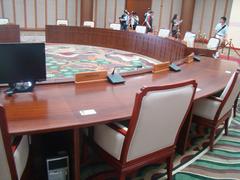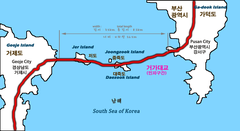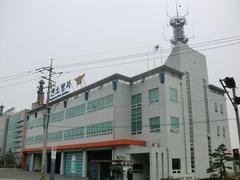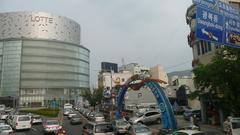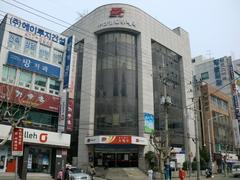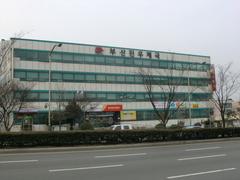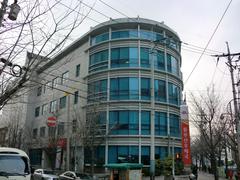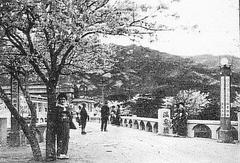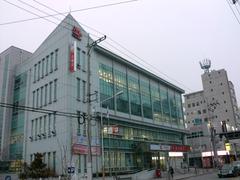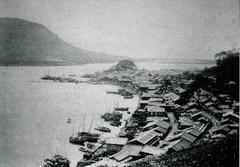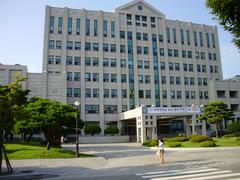Jigegol Station Visiting Hours, Tickets, and Tourist Guide in Busan, South Korea
Date: 04/07/2025
Introduction: Discover Jigegol Station—Your Gateway to Busan
Jigegol Station (지게골역) is more than a stop on Busan’s extensive metro network; it is a vibrant hub that connects travelers to the heart of the city’s Nam District, renowned for its local authenticity, historical significance, and access to some of Busan’s most fascinating urban and cultural landscapes. As a key node on Busan Metro Line 2, Jigegol Station offers both convenient transit and a springboard for exploring the rich heritage, diverse neighborhoods, and local attractions that define South Korea’s second-largest city (Busan Metropolitan City; Open Korea).
This comprehensive guide provides essential information about Jigegol Station’s operating hours, ticketing, facilities, accessibility, and nearby points of interest. Whether you’re a daily commuter or an international traveler eager to experience authentic Busan, understanding Jigegol Station’s role in the city’s development will enhance your journey.
Contents
- Introduction: Discover Jigegol Station and Busan’s Rich Heritage
- Busan Historical Overview: From Ancient Origins to Modern Metropolis
- The Metro System and Jigegol Station’s Role
- Station Visiting Hours, Ticket Options, and Accessibility
- Facilities and Services at Jigegol Station
- Exploring Nam District: Culture, Daily Life, and Attractions
- Travel Tips for Visitors
- Nearby Sights and Local Experiences
- Seasonal & Practical Advice
- Frequently Asked Questions (FAQs)
- Summary & Final Tips
- Sources and Further Reading
Busan Historical Overview: From Ancient Origins to Modern Metropolis
Busan’s roots stretch back to the Paleolithic era, evolving through the influential Geumgwan Gaya kingdom—an Iron Age powerhouse—before becoming a vital port and trade hub during the Joseon dynasty (Busan Metropolitan City). Over centuries, its strategic coastal position shaped its destiny, culminating in its role as a refuge during the Korean War and its thriving status today as a cosmopolitan port city (Open Korea; Explore City Life).
The Metro System and Jigegol Station’s Role
To meet the demands of rapid urban expansion, Busan’s metro (HuMetro) was developed, now boasting four lines and over 100 stations (UrbanRail.Net). Jigegol Station, situated in Munhyeon-dong, Nam District, was constructed to serve both bustling residential areas and emerging commercial zones (Wikipedia). With modern amenities, safety features, and multilingual signage, the station ensures a seamless experience for locals and visitors alike (Mapa Metro).
Station Visiting Hours, Ticket Options, and Accessibility
Operating Hours
- Jigegol Station operates daily from 5:00 AM to 11:00 PM, with trains running every 3–5 minutes during peak hours (UrbanRail.Net).
- Schedules may shift slightly on weekends and holidays. Always verify the latest times on the official Busan Metro website.
Ticketing
- Single journey tickets: Start at 1,300 KRW, available at station kiosks.
- Day Passes: Unlimited rides for 5,000 KRW—recommended for tourists and those planning multiple journeys.
- Transit Cards: Cashbee, T-Money, and Hanaro cards are accepted, offering easy transfers between metro and buses (Korea Travel Planning).
Accessibility
- Elevators, escalators, tactile paving, and barrier-free entrances throughout the station.
- Multilingual signage (Korean, English, Japanese, Chinese) for easy navigation.
- Facilities for the elderly, people with disabilities, and families with strollers.
Facilities and Services at Jigegol Station
- Clean Restrooms: Located within the station.
- Vending Machines & Convenience Stores: For snacks and travel essentials.
- Waiting Areas: Sheltered seating for passenger comfort.
- Safety: Platform screen doors, CCTV, and security personnel enhance passenger safety.
Exploring Nam District: Culture, Daily Life, and Attractions
Local Experiences
Jigegol Station opens the door to Busan’s authentic side, with access to:
- Traditional markets: Sample local street food, fresh produce, and regional delicacies.
- Community parks: Enjoy leisurely strolls or observe local life.
- Residential neighborhoods: See a blend of traditional and modern architecture.
Cultural Significance
The station’s surroundings reflect Busan’s resilience and openness, shaped by its history as a major coastal refuge and its post-war urban development (Korea Travel Planning).
Travel Tips for Visitors
- Plan trips within operating hours.
- Purchase a transit card for convenience and savings.
- Explore on foot: The area is safe and pedestrian-friendly.
- Avoid peak hours (7:30–9:00 AM, 5:30–7:00 PM) for a more relaxed experience.
- Leverage navigation apps (Naver Map, KakaoMap) and multilingual station staff.
Nearby Sights and Local Experiences
While Jigegol Station lies in a local district, it’s a launchpad for Busan’s top attractions:
Geumjeongsan Mountain & Fortress
- Hiking trails, panoramic views, and centuries-old fortress walls.
- Closest metro: Oncheonjang Station, then local bus/taxi (seoulkoreaasia.com).
Beomeosa Temple
- Historic Buddhist site dating to 678 AD.
- Metro to Beomeosa Station, then bus 90 (adventurebackpack.com).
Gamcheon Culture Village
- Colorful hillside village with art, murals, and local crafts.
- Metro to Toseong Station, then short walk/bus (seoulkoreaasia.com).
Jagalchi Fish Market
- Korea’s largest seafood market.
- Metro to Jagalchi Station (adventurebackpack.com).
Gwangalli Beach & Gwangan Bridge
- Beachfront cafes and spectacular night views.
- Accessible via Line 2 transfer (seoulkoreaasia.com).
Local Markets
- Gukje Market and Bupyeong Kkangtong Market offer authentic street food and shopping.
Seasonal & Practical Advice
- Spring/Autumn: Best for hiking, festivals, and cherry blossoms or foliage (exponentialtravels.com).
- Summer: Beach season; book accommodations early (whereandwhen.net).
- Winter: Mild but quieter; ideal for hot springs and indoor attractions.
Frequently Asked Questions (FAQs)
Q: What are the operating hours of Jigegol Station?
A: 5:00 AM to 11:00 PM daily (check official schedules).
Q: How do I buy tickets?
A: At vending machines, with cash or card, or use transit cards for faster access.
Q: Is the station accessible for people with disabilities?
A: Yes—elevators, tactile paving, and accessible restrooms are available.
Q: Are there guided tours or special events at Jigegol Station?
A: No regular tours, but the area offers local events and easy access to citywide festivals.
Q: How do I reach Gimhae International Airport?
A: Transfer at Seomyeon Station to Line 2, then connect to the Busan-Gimhae Light Rail at Sasang Station.
Summary and Final Tips
Jigegol Station stands as both a practical transit point and a window into Busan’s local life. With early morning to late-night operations, modern facilities, and excellent accessibility, it is well-suited for all travelers. The station’s integration into Busan’s broader transport network makes it an ideal starting point for exploring historic sites, vibrant markets, and scenic nature spots (UrbanRail.Net; Mapa Metro). For an enriching and seamless visit, use a transit card, plan ahead with travel apps, and embrace the unique character of Nam District.
Sources and Further Reading
- Busan Metropolitan City, History of Busan
- Open Korea, Busan: A Historical Journey
- UrbanRail.Net, Busan Metro
- Wikipedia, Jigegol Station
- Mapa Metro, Busan Subway Map
- Korea Travel Planning, Busan Transportation
- Namu Wiki, Busan Metropolitan Area
- Seoul Korea Asia, Things to Do in Busan
- Adventure Backpack, Busan Culture
- Metroeasy, Busan Metro
- Official Busan Metro Website
- Busan Tourism Organization
- Audiala App

